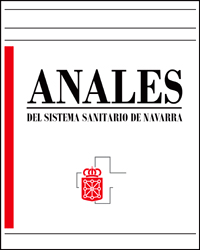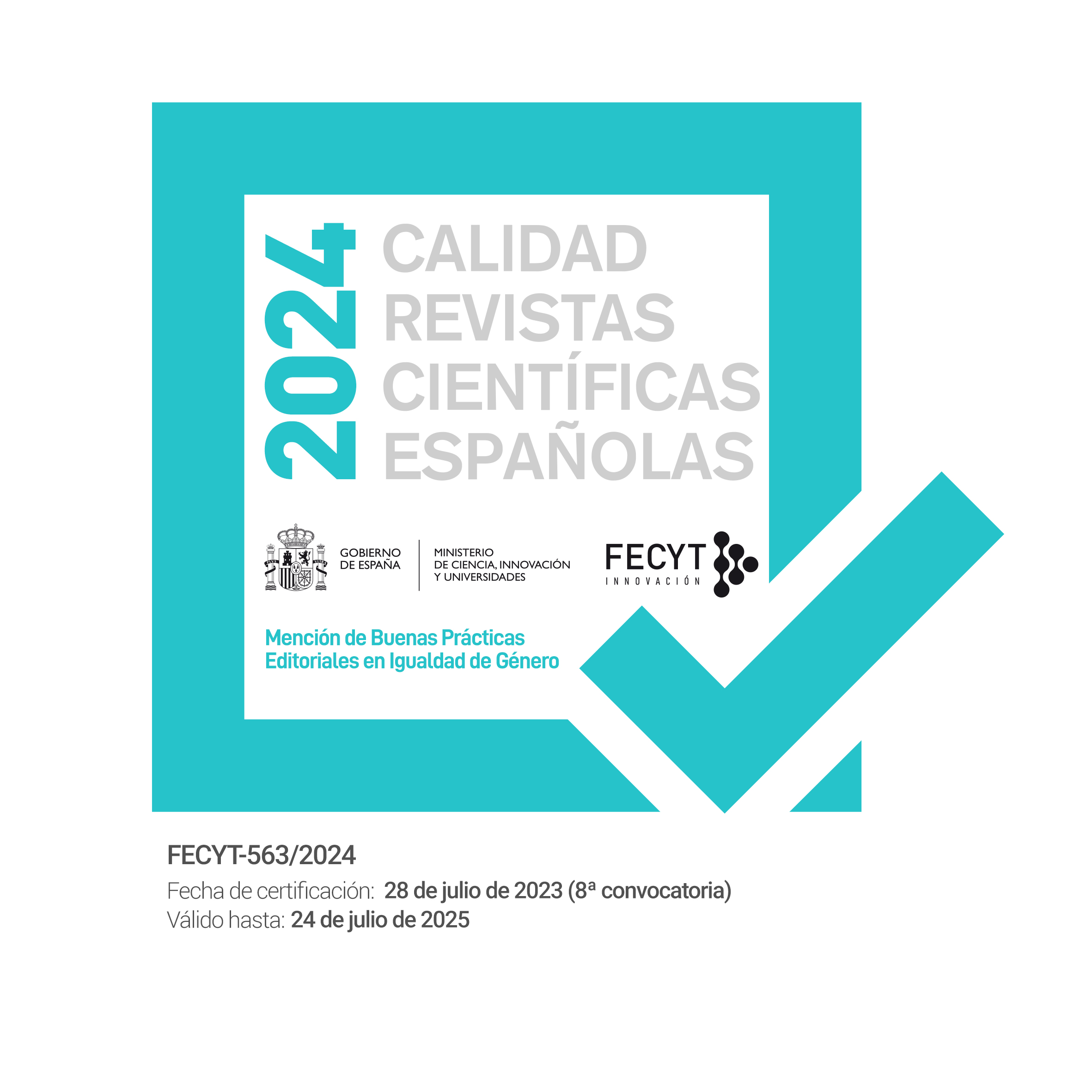Trends in the epidemiology of pertussis in Malaga, Spain (2017-2024)
DOI:
https://doi.org/10.23938/ASSN.1091Keywords:
Whooping Cough, Hospitalization, Vaccination, Disease Notification, Public Health SurveillanceAbstract
Background. Description of the epidemiological evolution of pertussis in the province of Malaga, Spain (2017 - 2024), disease severity, and vaccination coverage.
Methods. A cross-sectional study was conducted using reported cases from the Andalusian Notifiable Diseases Network (RedAlerta). The incidence of pertussis was calculated per 100,000 inhabitants for each health district, quarter, and year. Additionally, the relationship between severe cases (hospitalizations) and vaccination status was analyzed.
Results. A total of 181 pertussis cases were identified. Of these, 56.4% were reported during the pre-pandemic period (2017-2019), while 9.95% occurred between 2020 and 2023. An increase in cases was observed in the first quarter of 2024 (n = 61; 33.7% of the total cases), compared to previous years (1 to 46 cases). The 0 to 20-year group accounted for 71.3% of cases, of which 57.4% had received at least partial vaccination prior to contracting pertussis. Severe disease requiring hospitalization occurred in 25.6% of cases, with a higher frequently among unvaccinated individuals (70% vs 18.3%; p < 0.001). Among hospitalized cases, 42.4% had not received any prior doses of the vaccine. Additionally, 47.1% of the 17 pertussis cases in children aged ≤1 year had not received any vaccination and had no history of maternal vaccination during pregnancy.
Conclusions. An increase in reported pertussis cases is observed in early 2024 in Malaga, but hospitalization rates among confirmed cases remained stable. A significant association is found between prior vaccination against pertussis and reduced disease severity (hospitalization) in the 0 to 20-year-old age group.
Downloads
References
IGLESIAS L, CASABELLA PERNAS A, HERNÁNDEZ FEBLES M, COLINO GIL E, EISMAN MARAVER A, PENA LÓPEZ MJ. Estudio clínico-epidemiológico de la infección por Bordetella pertussis en la isla de Gran Canaria en el período 2008-2016. An Pediatr 2018; 89(3): 170-175. https://doi.org/10.1016/j.anpedi.2017.10.013
RODRÍGUEZ ARRANZ C, ALBAÑIL BALLESTEROS MR, GARCÍA VERA C, BLASCO ALBERDI M, GIL DE GÓMEZ MJ. Diagnostic study of pertussis using PCR in primary care clinics. An Pediatr 2022; 97(4): 262-269. https://doi.org/10.1016/j.anpede.2022.02.005
YESQUEN P, HERRERA-PEREZ E, ESCALANTE-KANASHIRO R. Clinical and epidemiological characteristics of whooping cough in hospitalized patients of a tertiary care hospital in Peru. Revi Bras Ter Intensiva 2019; 23;31(2): 129-137. https://doi.org/10.5935/0103-507x.20190029
Consejería de Salud y Consumo de la Junta de Andalucía. Protocolo de vigilancia y control de la tosferina. Junta de Andalucía; 2012. https://juntadeandalucia.es/export/drupaljda/salud_5af95879cd397_p_tosferina.pdf
European Centre for Disease Prevention and Control. Increase of pertussis cases in the EU/EEA. ECDC; 2024. https://www.ecdc.europa.eu/en/publications-data/increase-pertussis-cases-eueea
Instituto de Salud Carlos III. Informe de situación provisional de la tosferina, julio 2024. ISCIII 2024. https://cne.isciii.es/documents/d/cne/informe_tosferina_brote_2023-2024-23-julio-2024?download=true
LIMIA SÁNCHEZ A, OLMEDO LUCERÓN C. 2º Estudio de seroprevalencia en España 2017-2018. Rev Esp Salud Pública 2021; 18(95): e202103059.
Sociedad Española de Infectología Pediátrica. Posicionamiento sobre la tosferina. SEIP, 2015. https://www.seipweb.es/wp-content/uploads/2019/01/Nota_SEIP_Tos_ferina_SEIP2_Nov2015.pdf
GENTILE Á, TORRES-TORRETI JP, LÓPEZ-LÓPEZ P, ULLOA-GUTIERREZ R. Cambios epidemiológicos y actualidades sobre vacunación contra Bordetella pertussis en Latinoamérica. Rev Chilena Infectol 2021; 38(2): 232-242. https://doi.org/10.4067/s0716-10182021000200232
CHERRY JD. The 112-Year odyssey of pertussis and pertussis vaccines - mistakes made and implications for the future. J Pediatric Infect Dis Soc 2019; 8(4): 334-341. https://doi.org/10.1093/jpids/piz005
Consejería de Salud y Consumo. Comunicado de la Consejería de Salud y Consumo sobre tosferina. Servicio Andaluz de Salud, 2024. https://www.sspa.juntadeandalucia.es/servicioandaluzdesalud/archivo-comunicado/comunicado-de-la-consejeria-de-salud-y-consumo-sobre-tosferina
LEÓN-MORILLO MDR, GOMEZ-PASTRANA D, DÍAZ-COLOM MC, QUECUTY-VELA S, ALADOS-ARBOLEDAS JC, ARAGÓN-FERNÁNDEZ C. Effect of pertussis vaccine in pregnancy and COVID-19 pandemic in the cases of wooping cough. Enferm Infecc Microbiol Clin 2022; 40(9): 499-502. https://doi.org/10.1016/j.eimc.2021.07.007
GIL-PRIETO R, WALTER S, SAN-ROMÁN-MONTERO J, MARÍN-GARCÍA P, GONZÁLEZ-ESCALADA A, GIL-DE-MIGUEL A. Paediatric hospitalizations due to whooping cough in Spain (1997-2017). Vaccine 2019; 37(43): 6342-6347. https://doi.org/10.1016/j.vaccine.2019.09.017
Servicio Andaluz de Salud. Nuevo mapa sanitario de Andalucía: Distritos de Atención Primaria y Zonas Básicas de Salud. https://www.sspa.juntadeandalucia.es/servicioandaluzdesalud/sites/default/files/sincfiles/wsas-media-pdf_publicacion/2020/MapaAPSevilla.pdf
Junta de Andalucía. Orden de 28 de julio de 2023, por la que se dejan sin efecto las medidas sanitarias por razón de la salud pública para la contención de la COVID-19 en Andalucía. Junta de Andalucía 2023. https://juntadeandalucia.es/boja/2023/149/BOJA23-149-00002-13066-01_00288074.pdf
GENTILE A, ROMANIN VS, JUÁREZ MDEL V, LUCIÓN MF, MARQUES MDE L, MISTCHENKO AS. Epidemiology of Bordetella pertussis in a children's hospital. Arch Argent de Pediatr 2014; 112(1): 26-32. https://doi.org/10.5546/aap.2014.eng.26
MARTÍNEZ LORENZO R, GONZÁLEZ PIÑEIRO Y, LÓPEZ VÁZQUEZ AM, TRIGO DAPORTA M. Incremento en el número de casos diagnosticados de tosferina; ¿pensamos más en ella? Atención Primaria 2017; 49(5):309-311. https://doi.org/10.1016/j.aprim.2016.09.006
GANGOITI I, MARTINEZ-FERNANDEZ E, GARMENDIA O, DIEZ A, MINTEGI S. Impacto de la vacunación en embarazadas sobre la reemergencia de la tosferina y su forma de presentación en urgencias. An Pediatr 2020; 93(2): 129-131. https://doi.org/10.1016/j.anpedi.2019.11.002
Centers for Disease Control and Prevention. Pregnancy and whooping cough: vaccine effectiveness. CDC 2024. https://www.cdc.gov/pertussis/hcp/vaccine-recommendations/vaccinating-pregnant-patients.html?CDC_AAref_Val=https://www.cdc.gov/pertussis/pregnant/hcp/vaccine-effectiveness.html
COFRÉ J. Vacunas anti-pertussis: acelular versus celular. ¿Acaso un regreso al pasado? Rev Chilena de Infectol 2015; 32(5): 559-63. https://doi.org/10.4067/s0716-10182015000600010
HINCAPIÉ D, ACEVEDO M, HOYOS MC, OCHOA J, GONZÁLEZ C, PÉREZ PA et al. Serosurveillance for vaccine-preventable diseases: A look inside the pertussis experience. Biomedica 2019; 39: 130-143. https://doi.org/10.7705/biomedica.v39i4.4181
JAMISON DT, BREMAN JG, MEASHAM AR, ALLEYNE G, CLAESON M, EVANS DB et al. Disease control priorities in developing countries. 2nd edition. New York: Oxford University Press, 2006. https://www.ncbi.nlm.nih.gov/books/NBK11728/
LAST JM, ADELAIDE DP. The iceberg: 'completing the clinical picture' in general practice. 1963. Inter J Epidemiol 2013; 42(6): 1608-1613. https://doi.org/10.1093/ije/dyt113
BHOPAL, RS. Interrelated concepts in the epidemiology of disease: Natural history and incubation period, time trends in populations, spectrum, iceberg, and screening, Oxford Academic, 2016. https://doi.org/10.1093/med/9780198739685.003.0006
INTHAMOUSSU M, VIROGA S, SPERANZA N. Factores que influyen en la adherencia a la vacuna contra la tosferina en mujeres embarazadas en Uruguay. Rev Chilena Infectol 2021; 38(3): 362-369. https://doi.org/10.4067/s0716-10182021000300362
BOSCH JJ, FERNÁNDEZ H, POLAK FP, MUSANTE G, LIBSTER R, ROCCA RIVAROLA M. Seroprevalence of Bordetella pertussis among vaccinated and unvaccinated pregnant women and newborn infants in a university hospital of Buenos Aires. Arch Argent Pediatr 2017; 115(4): 311-315. https://doi.org/10.5546/aap.2017.eng.311
Downloads
Published
How to Cite
Issue
Section
License

This work is licensed under a Creative Commons Attribution-ShareAlike 4.0 International License.
La revista Anales del Sistema Sanitario de Navarra es publicada por el Departamento de Salud del Gobierno de Navarra (España), quien conserva los derechos patrimoniales (copyright ) sobre el artículo publicado y favorece y permite la difusión del mismo bajo licencia Creative Commons Reconocimiento-CompartirIgual 4.0 Internacional (CC BY-SA 4.0). Esta licencia permite copiar, usar, difundir, transmitir y exponer públicamente el artículo, siempre que siempre que se cite la autoría y la publicación inicial en Anales del Sistema Sanitario de Navarra, y se distinga la existencia de esta licencia de uso.








